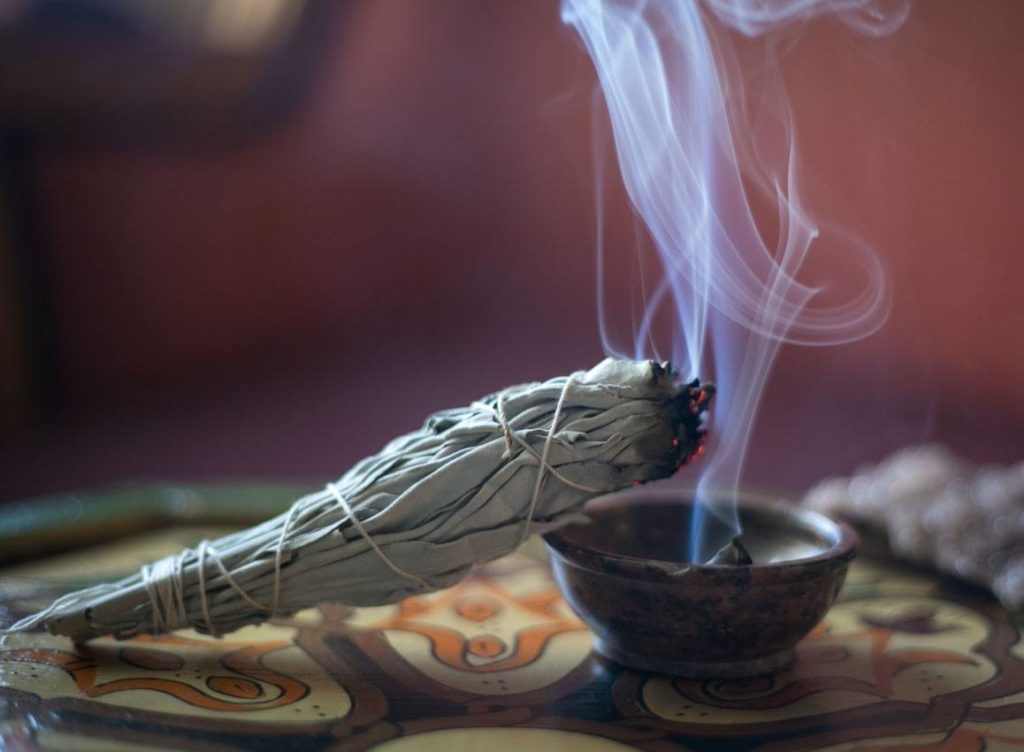You don’t have to be a shaman to have access to multiple levels of consciousness on a daily basis. From yoga classes at your local YMCA (or overpriced boutique gym) to Transcendental Meditation in public schools, meditation is an ancient ritual that has adapted to modern society to offset the fast pace, neglect of our physical bodies, and sense of disconnect that many of us experience, awakening depths of consciousness that many of us have not been accustomed to exploring. You might not even know what “shamanic healing” means, but even modern medicine has taken a shamanic turn and has begun to dedicate clinical studies to hallucinogens that have been shown to treat mental conditions through micro-doses and full-on trips, treating everything from anxiety to addiction to PTSD.
Here are seven ways that ritual and ancient traditions have made themselves indispensable fixtures in modern, everyday life.
Meditation in Education

The Chicago Tribune published a story a few years ago about how Chicago Public Schools had implemented “Quiet Time,” a meditation program designed to reduce toxic stress levels in its students as a way to curb youth violence. “I was a real belligerent person and a hothead before, and it’s really calming and releases stress,” said a student, who added that Quiet Time also led to open-mindedness. Even teachers benefited from Quiet Time. “I’ve seen a transformation of how we, how I, handle conflict in the classroom,” said one of them. Another described a feeling of being able to let the positive energy in, and a sense of indomitable spirit in the face of obstacles. Beyond anecdotal evidence of meditation’s benefits in education, the school reported better test scores, fewer suspensions, and an overall better learning experience for its students.
A 2015 article in The Atlantic covered the changes that occurred at a San Francisco public school after adopting Quiet Time. The school, situated in a neighborhood marred by violence, incarceration, and poverty, saw a dramatic improvement in grades and drop in suspension rates. “In the first year of Quiet Time, the number of suspensions fell by 45 percent,” wrote a public policy expert who had been following the school’s transformation. “Within four years, the suspension rate was among the lowest in the city. Daily attendance rates climbed to 98 percent, well above the citywide average. Grade point averages improved markedly.” More importantly, the school became one of the happiest schools in San Francisco — even happier than those in high-income neighborhoods.
Workplace Wellness

Wellness has gotten its foot in the door of the corporate market under the pretense that happier workers lead to better productivity. That premise in itself is a bit cultish and cringeworthy, but at the end of the day, one hopes that a company really does have the wellbeing of its employees in mind for reasons beyond the company’s financial gain.
Genentech, a large corporation, told CNBC last fall that they made the decision to offer the Headspace app as a sponsored health benefit for their employees based on real results. Headspace, a subscription-based app, has a structured program with guided meditations that cover whatever you’d like to focus on for the session: sleep, stress, mindfulness. A company-sponsored study found that after just eight weeks of 10 to 20 minutes of using Headspace per day, its users saw a 30 to 45 percent decrease in anxiety and depression, as well as an improved sense of well-being. The results were so compelling that the company decided to offer Headspace membership to its 14,000 employees. “[It’s] critical to foster an environment where employees feel they can give their best.”
Mobile Zen

Nowadays, even the most plugged in person can unplug from everyday life by utilizing mobile technology. It sounds a bit counterintuitive to look to your tablet or smartphone to guide you toward your most elemental self, but especially if you are someone whose phone is within reach for the better part of the day, having on-demand, guided meditations at your fingertips is likely the only way you’ll actually take time to get your meditation on.
For example, along with other wellness prompts, Apple Watch users receive reminders throughout the day to take a minute or more to focus on simple breath-work. Samsung recently announced a partnership with Calm, a mindfulness platform that will be integrated with Samsung Health on smartphones as well as the Galaxy Watch Active. The app offers hundreds of guided meditations designed to support users’ mental and physical health through holistic wellness. “Having a global partner like Samsung bring the very best of Calm to new platforms, will help millions of users to manage stress, ease anxiety, and find more restful sleep,” said Calm in a statement released in March.
Burning Botanicals

It doesn’t have to be incense or a smudge stick to be rooted in shamanic practices. Think about how people even burn their run-of-the-mill Yankee Candles to alter the atmosphere of a space in a way that affects the mood or course of the people within it. Of course, burning an enchanted candle from an occult store is even more directly tied to ritualistic practices, as you’re lighting it with a specific intention of focus or change.
This shift of focus or momentum, generally speaking, is the ultimate goal of burning sacred items like palo santo, incense, smudge sticks, and fragrant gums such as frankincense and myrrh. The latter two were famously brought to the infant Jesus in Bethlehem by wise men shortly after the tale of his birth, but the fragrant botanicals were used thousands of years before Christianity in religious ceremonies in the Middle East; the use aromatics is a component of practically all Eastern and Western religions rooted in ancient practices.
Indigenous cultures also have used botanicals and aromatics ritualistically, and these traditions have lately been co-opted by modern, non-indigenous cultures for better or for worse. “Smudging is not just like, ‘I’m going to light this sage and have a glass of wine and all the bad spirits will get out of here.’ There’s a ceremonial way to do it,” said Amy Willier, a Cree from Sucker Creek First Nation in Alberta, in an interview with the Huffington Post. She took issue with vendors like Amazon, Sephora, and Urban Outfitters selling smudge stick starter kits marketed with vague buzzwords of spiritual hygiene and wellness.
Rather than denouncing the sale of these rituals though, Willier suggested that she was most concerned with the commercial misuse of these sacred items. “People are searching for meaning in their life, so we’re not saying, ‘No you can’t do it, it’s not yours to have’ ’cause smudging is a gift for everyone.” The concern is that without passing on the traditions that accompany these sacred items, the history and respect of indigenous practices will dissipate into thin air as soon as gentrifying consumers move onto other trends. Another complication of the globalization of smudging is that some of the botanicals used in indigenous cultures are being unsustainably harvested from the wild to fulfill consumer demand. White sage smudge sticks, for example, are so popular that the plant is now being watched closely by a medicinal plant conservation organization called the United Plant Savers.
High-Profile Purification Rituals

But the surge of interest in indigenous purification ceremonies is certainly more than just the commodification of indigenous practices. It’s also a contemporary reckoning and longing for cultures and connections that have been marginalized or destroyed completely by colonial forces. This past December, newly-elected Mexican President Andres Manuel Lopez Obrador, aka “Amlo,” was surrounded by a cloud of smoke as he partook in an indigenous cleansing ceremony as a way to honor his constituents. “We are going to give special attention to the indigenous people of Mexico,” he told the crowd. “It is a disgrace that our original communities live with oppression and racism, with poverty and marginalization.”
Even a National Geographic archaeologist recently made sure to go through a purification ritual before making his way into the underground caverns of Balamku, under the ancient Maya city of Chichén Itzá, where he and his team discovered a trove of Maya incense burners and other sacred artifacts; rather than plundering the findings for a museum, the team plans to leave the artifacts where they were found.
Soul-Searching Gatherings

Larry Harvey, the late founder of Burning Man, lit his first effigy with a group of friends over three decades ago as a personal ritual following a midlife crisis, according to an homage in the New Yorker that was published shortly after his death last spring. The festival has since become a sort of parallel universe in which its attendees challenge themselves to be citizens of “temporary metropolis dedicated to art and community.” “Burners” follow a set of ethics that eschews capitalism and instead asks its citizens to trade or gift items as a point of connection between one another, encouraging a more community-minded way of existing. Burning Man also makes a point to “leave to trace” in respect to the land, which requires its attendees to take stock of the impact their choices. Last year, over 70,000 people attended the festivities.
Other transformational gatherings have cropped up over the years, structuring themselves around yoga, music, wellness, and environmentalism. Envision Festival, based in Costa Rica, features a group of healers who call themselves the “Village Witches.” The Village Witches tap into a healing traditions from all around the globe that span modalities like energy work to sound baths to herbal medicine as a way to honor the wisdom of the past in the present day.
Psychedelic Medicine

Hallucinogens used in shamanic healing rituals are increasingly being studied and utilized in clinical settings to treat existential conditions like severe depression and PTSD. People from all across the globe are being introduced to ayahuasca, an entheogenic brew of plants from the Amazon that has historically been used as spiritual and medicinal healing by its local communities. Preliminary studies have found that ayahuasca has demonstrated the capacity to relieve symptoms of depression from patients whose condition had resisted conventional treatment with antidepressants, suggesting further exploration of how this ancient botanical ritual could reshape modern medicine and mental health.
For Image credit or remove please email for immediate removal - info@belatina.com







































